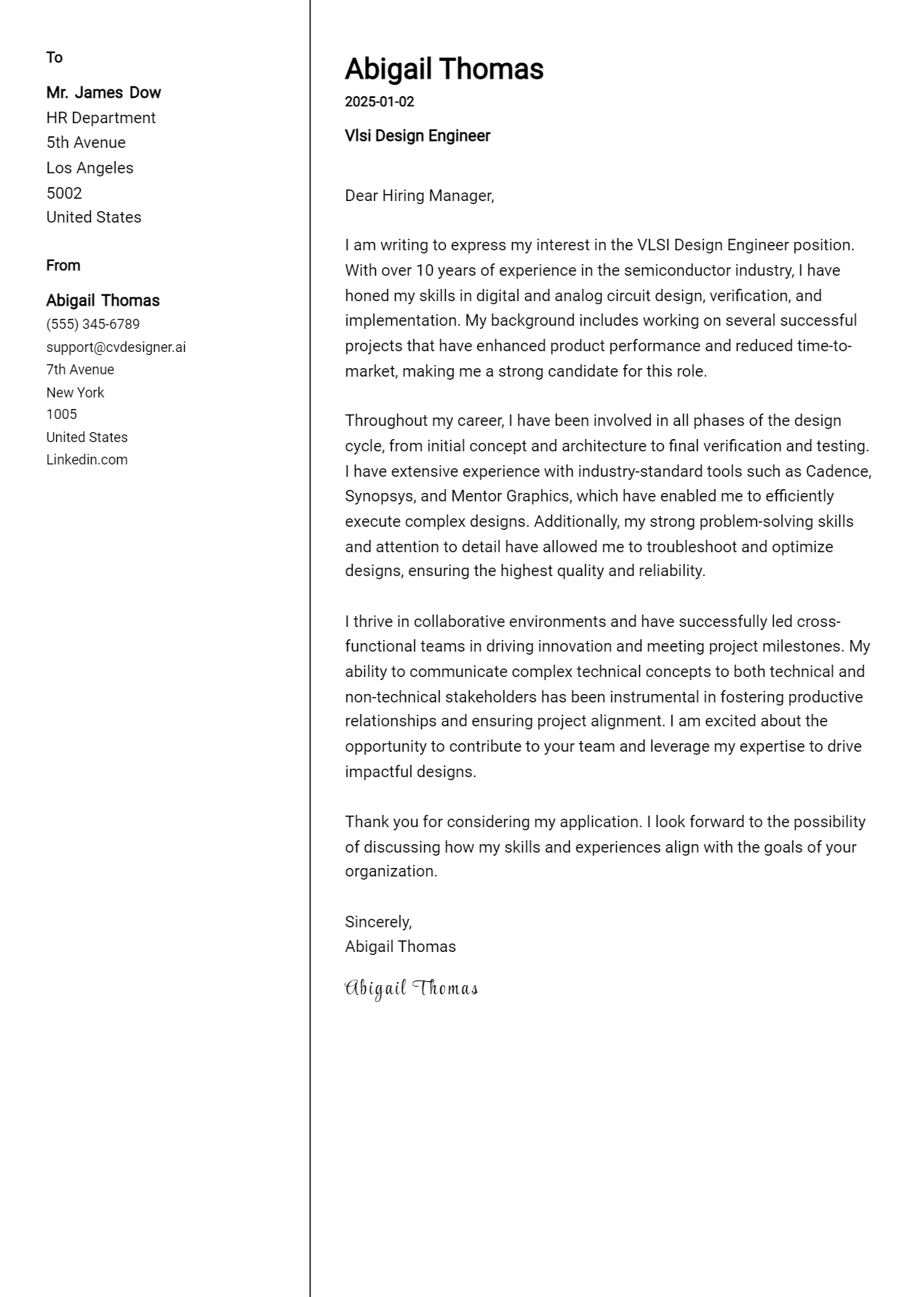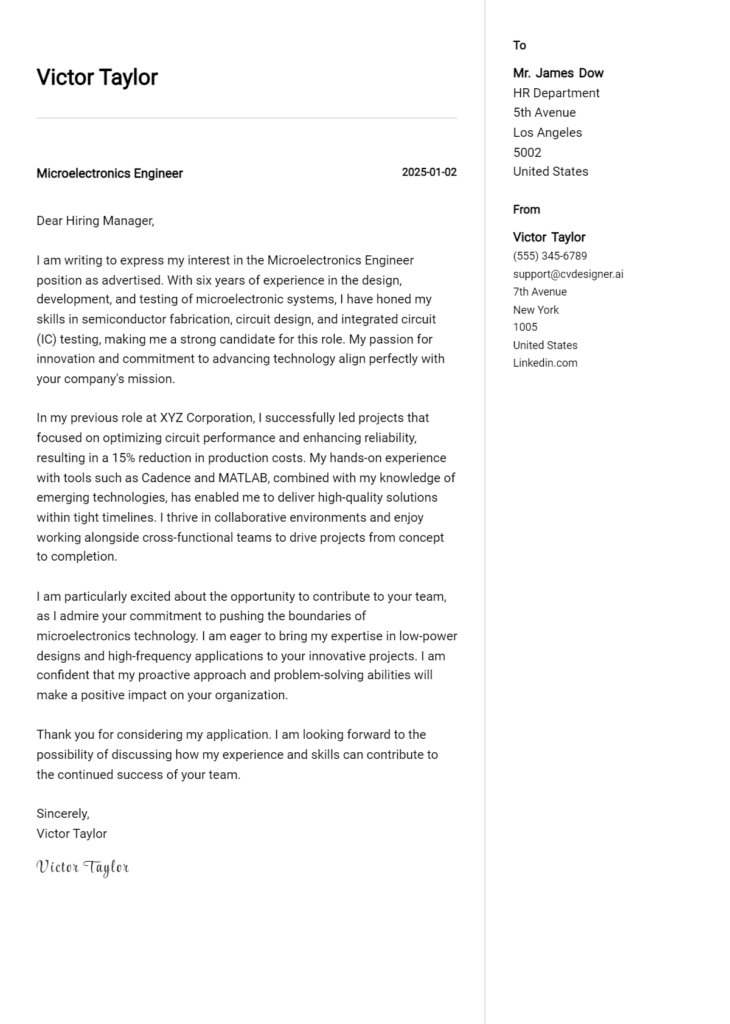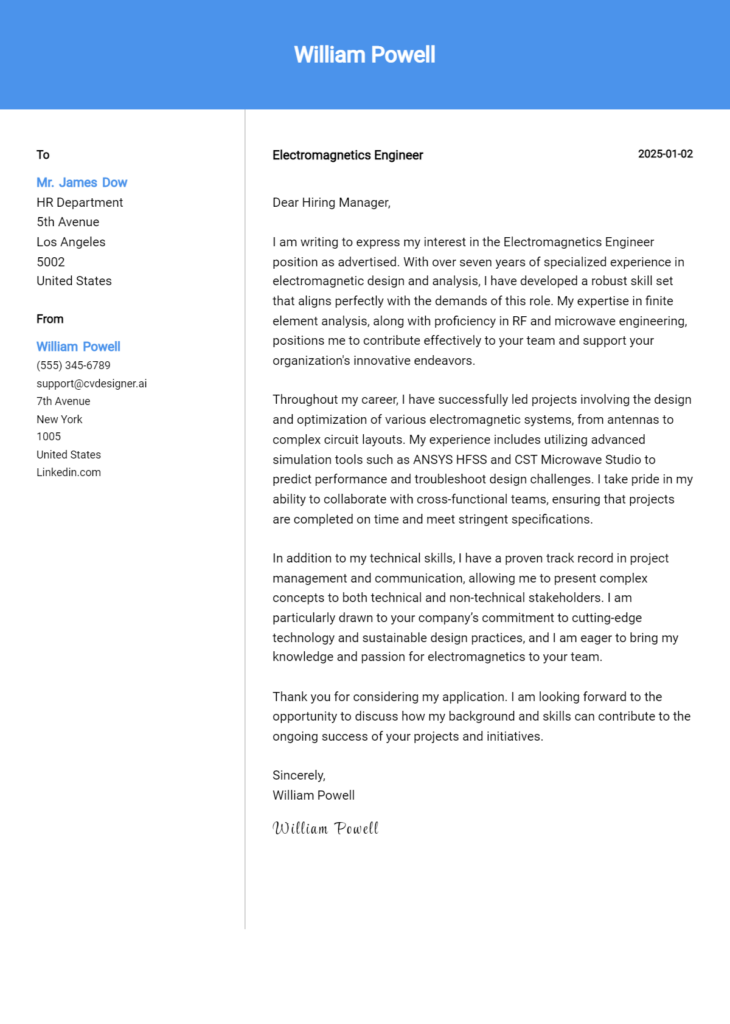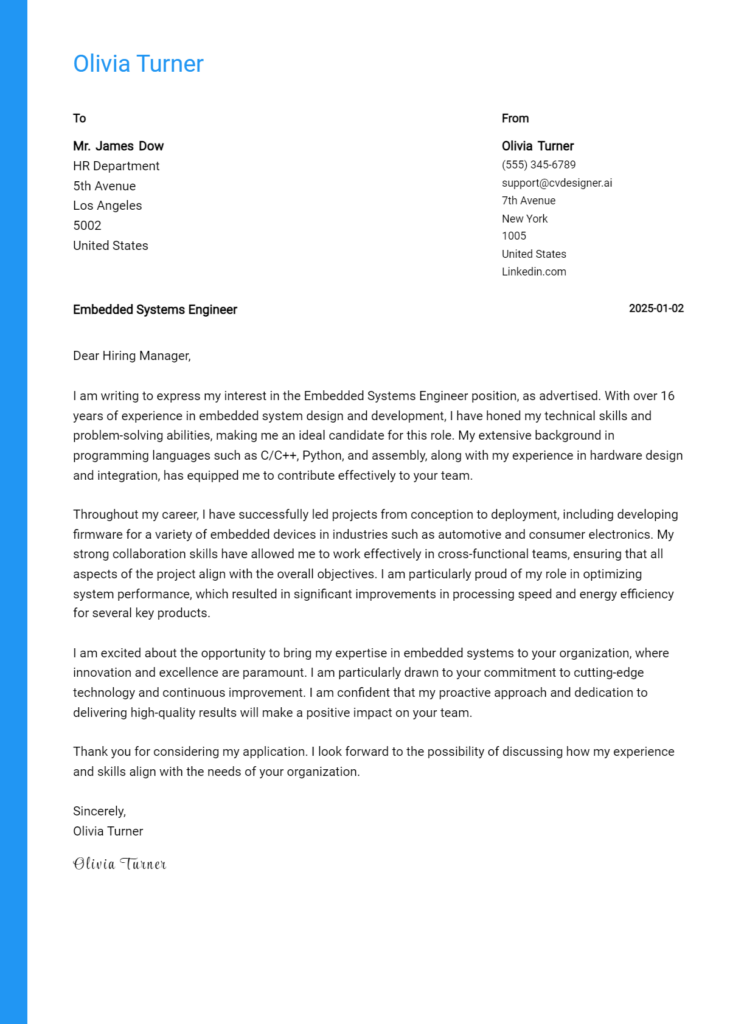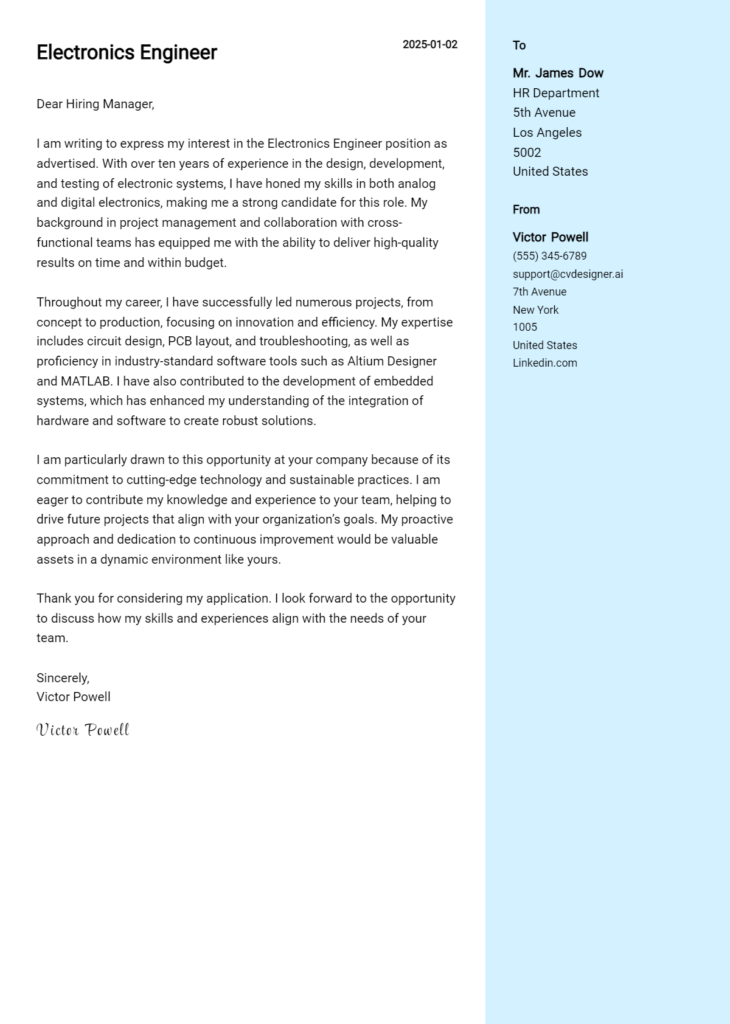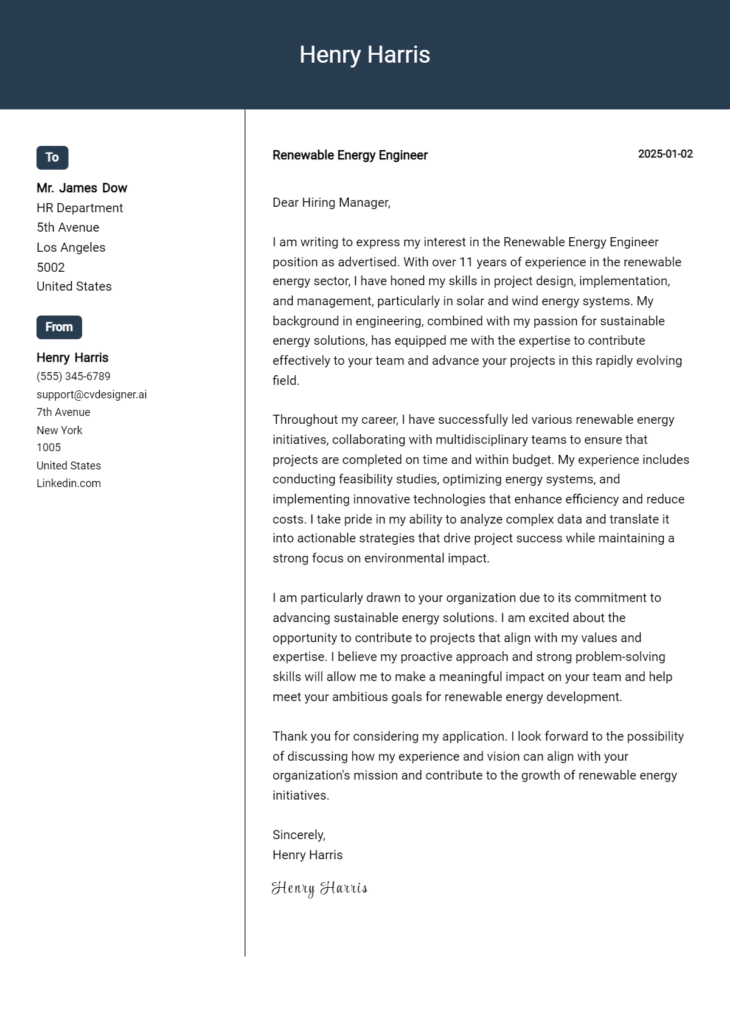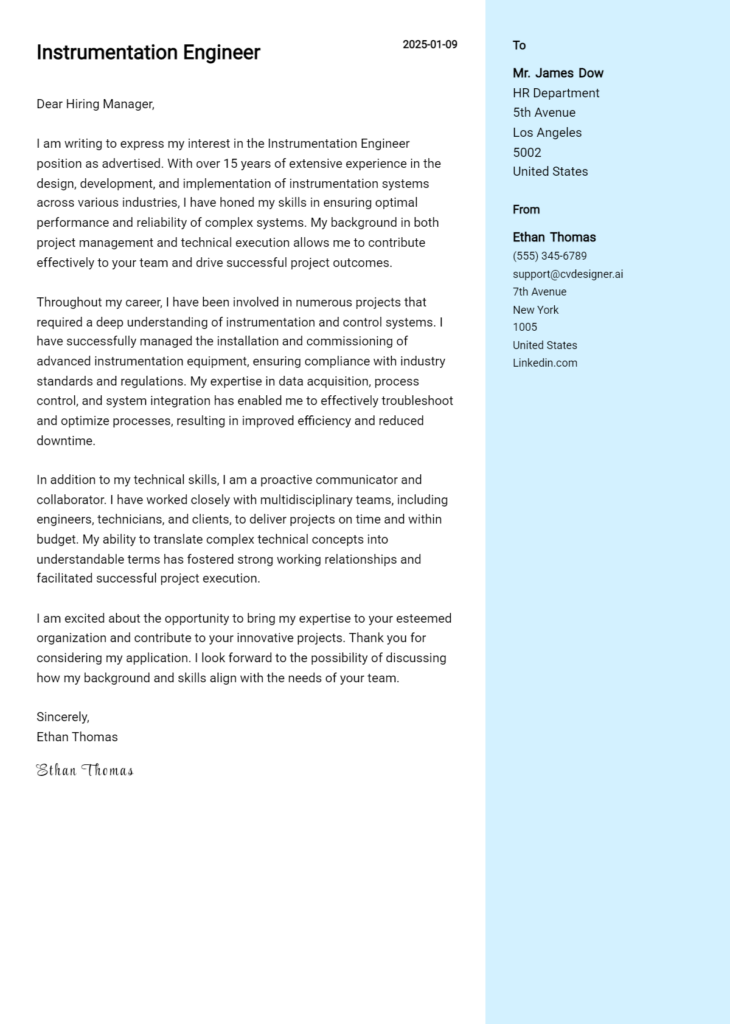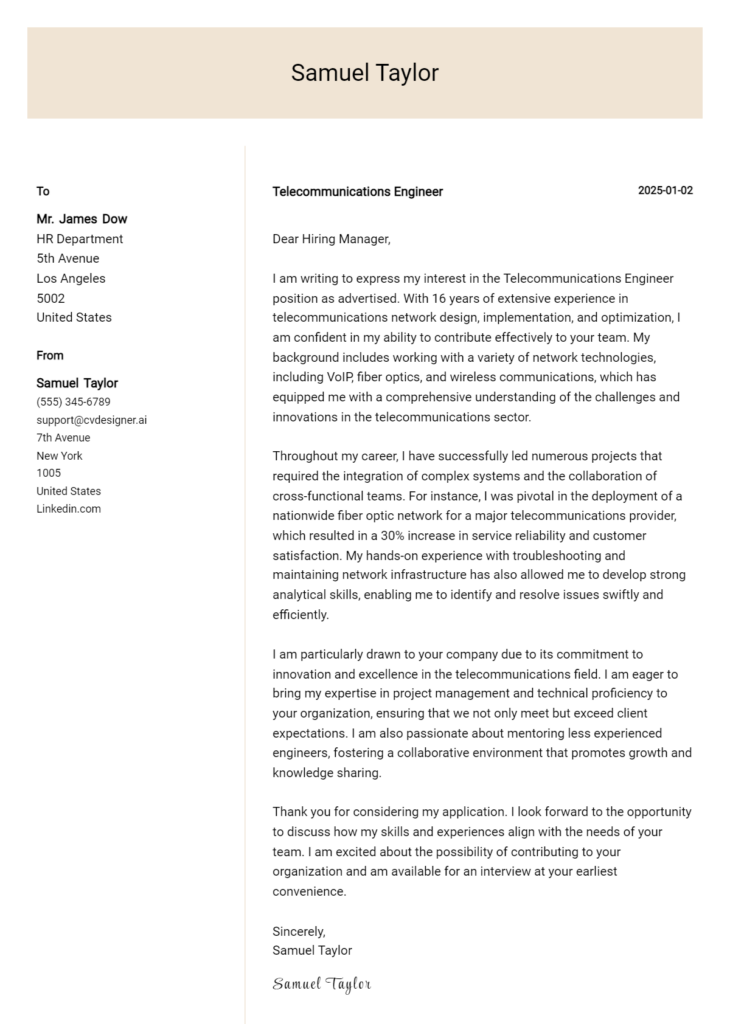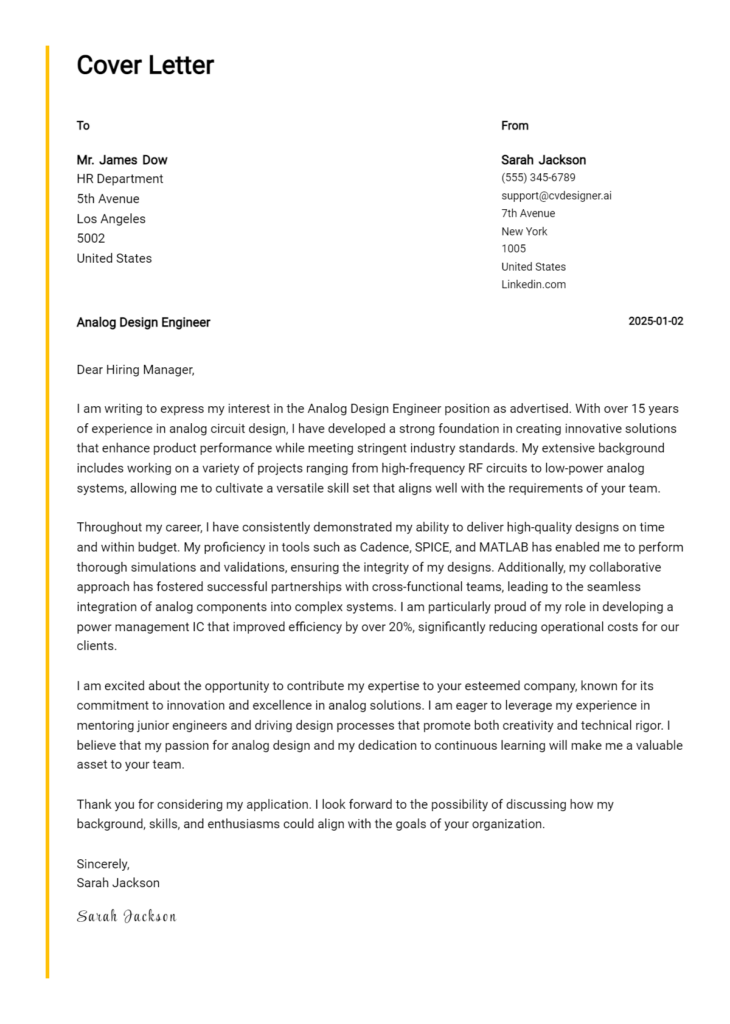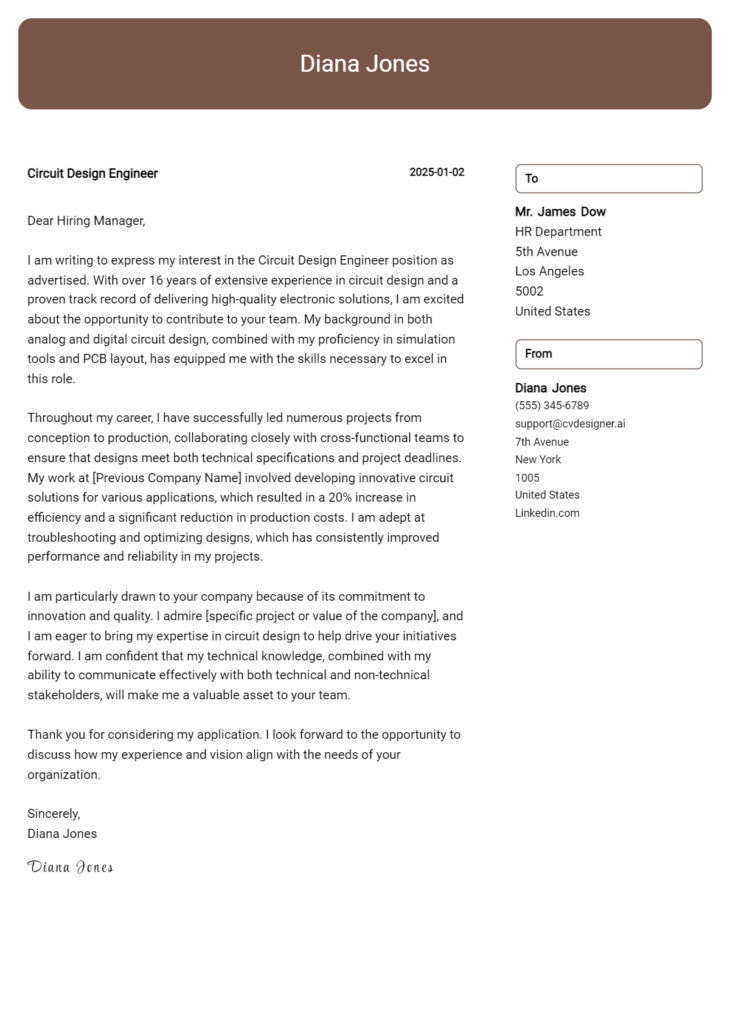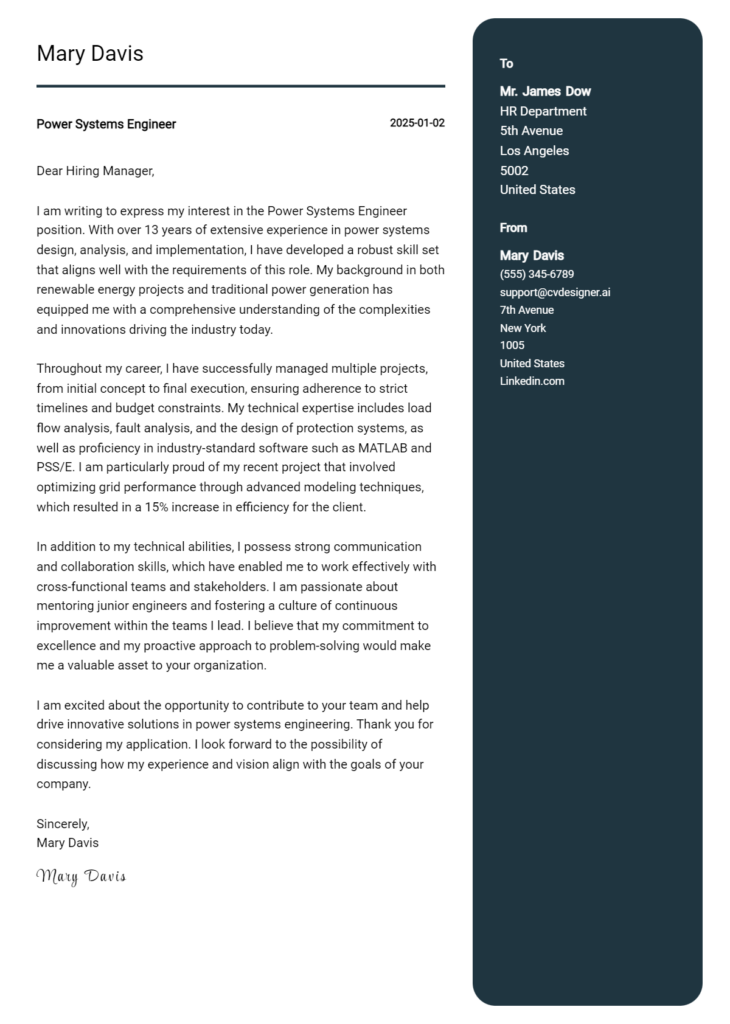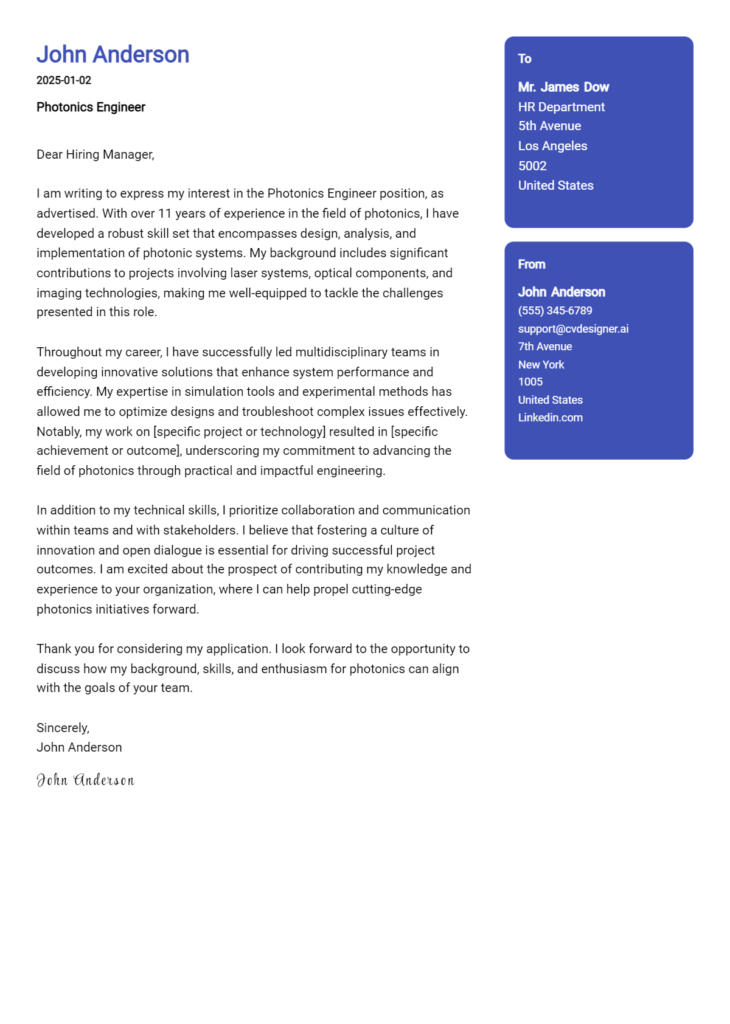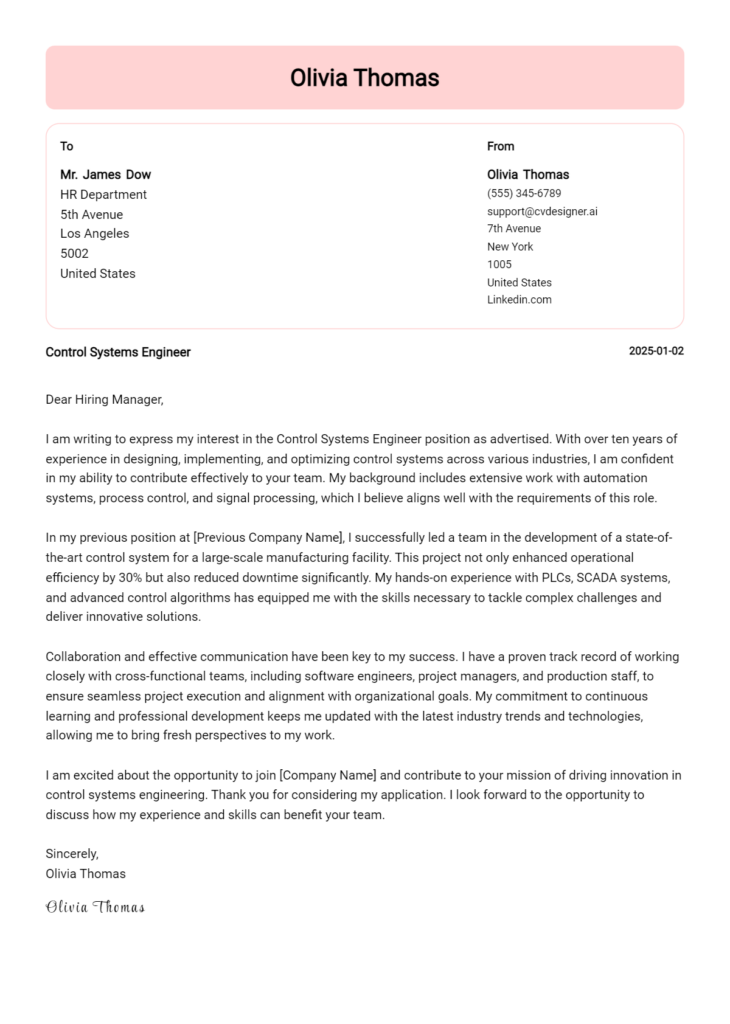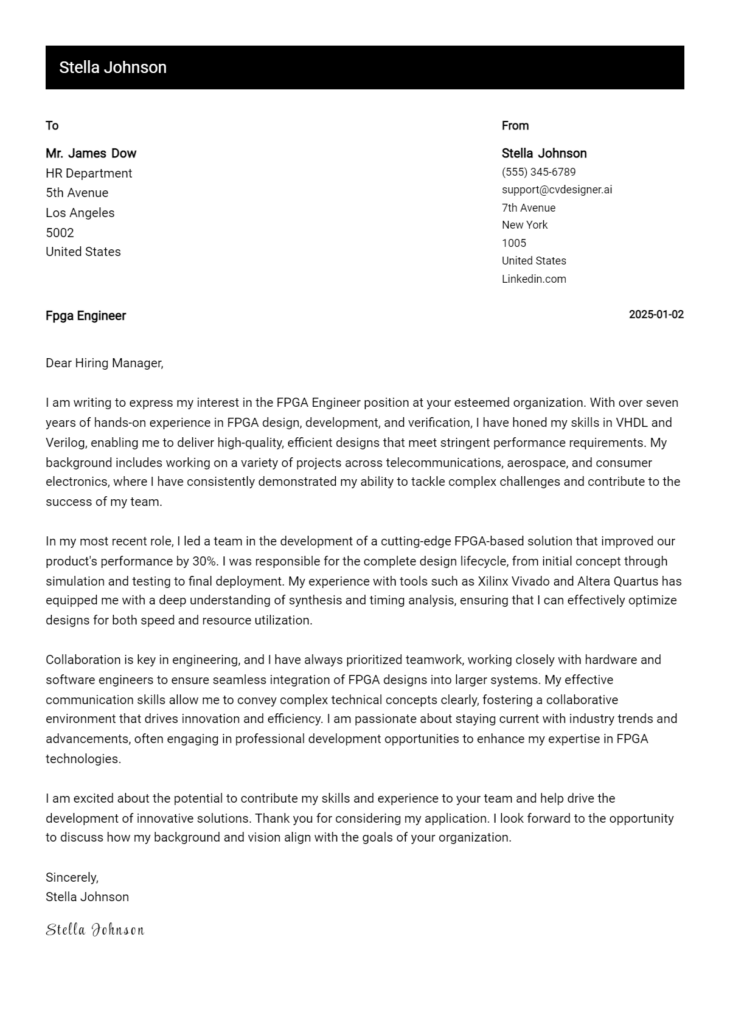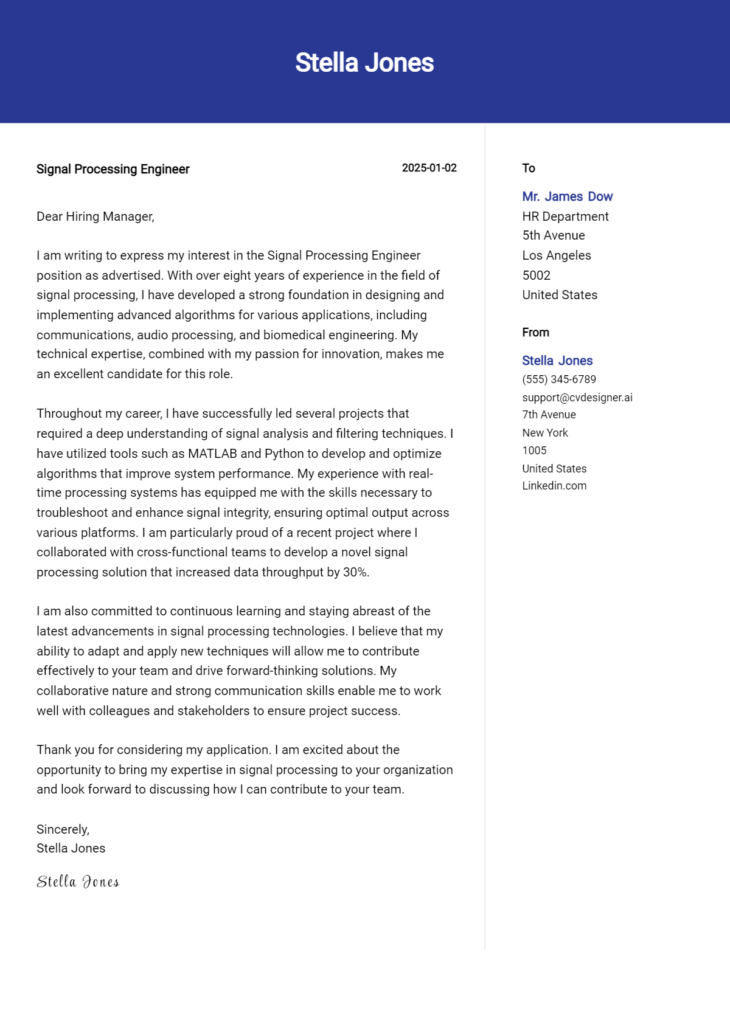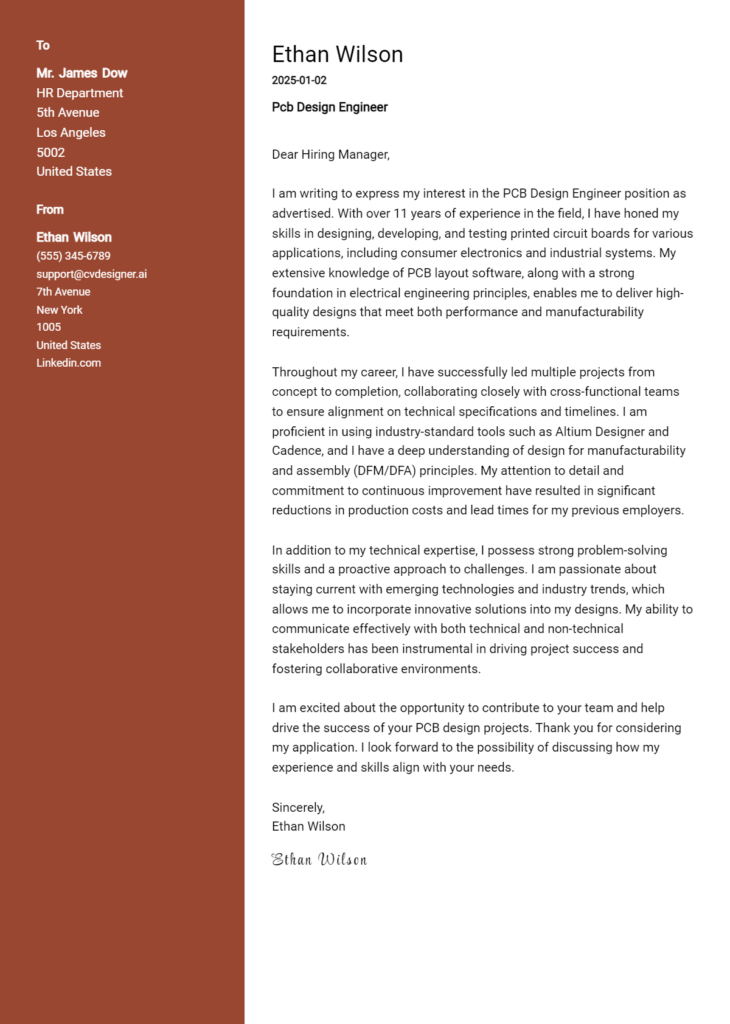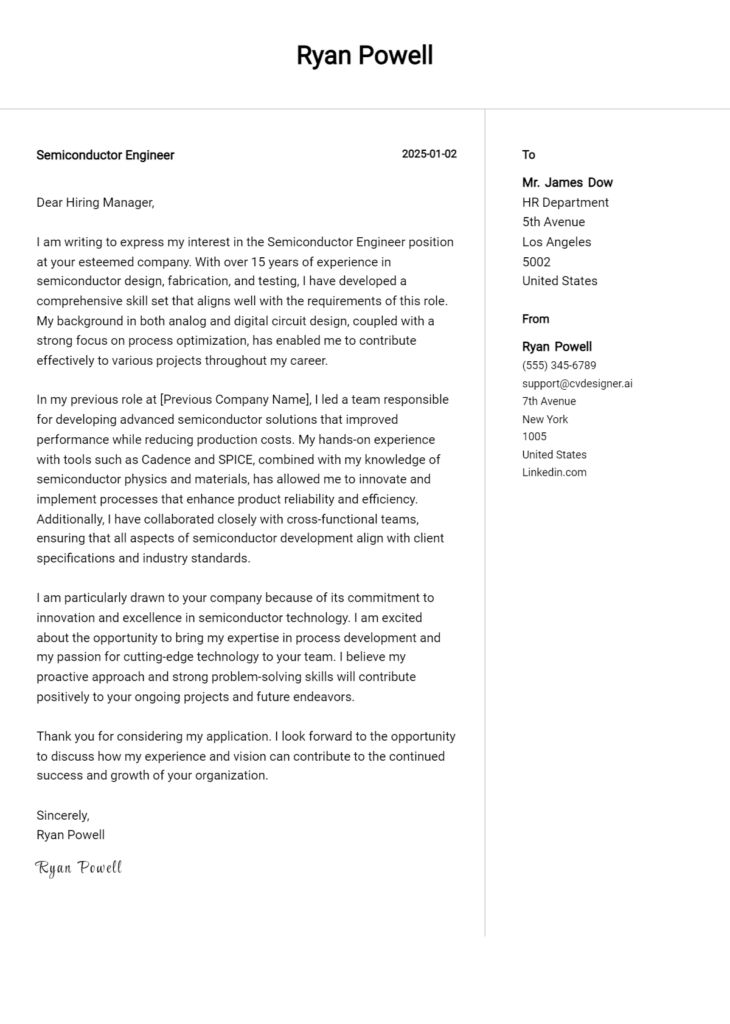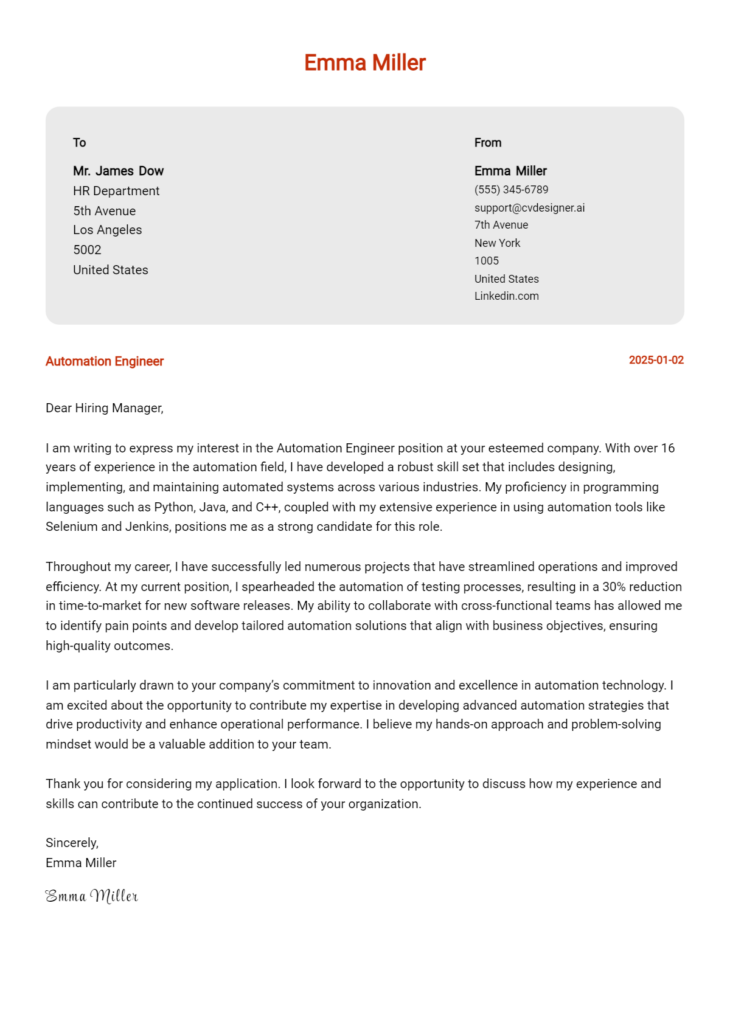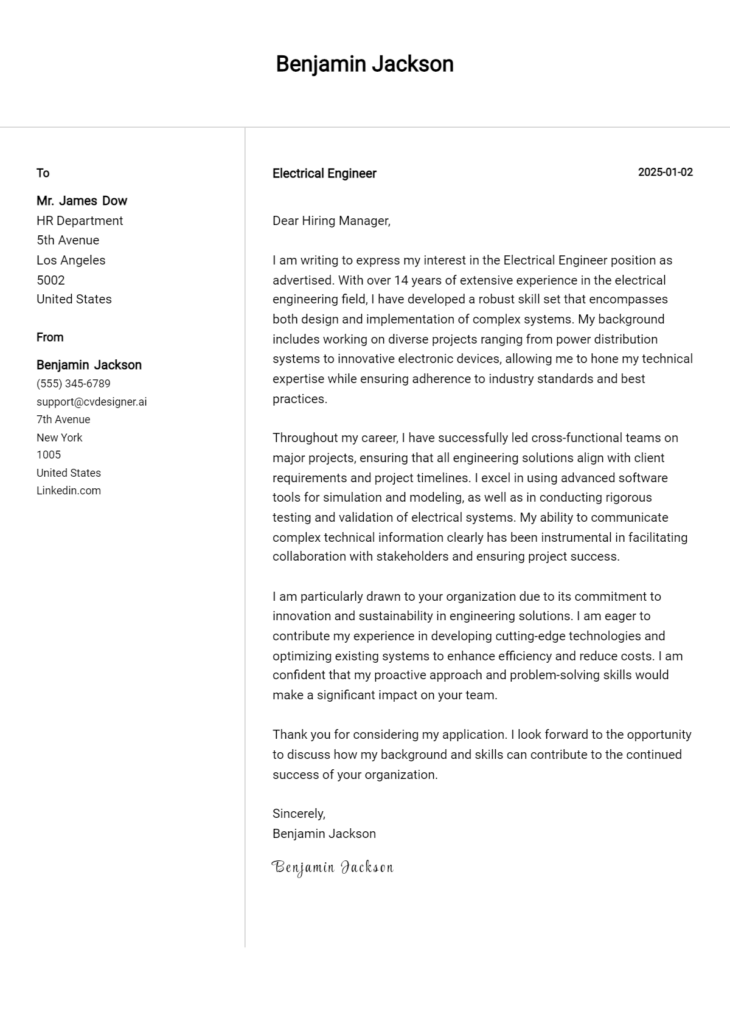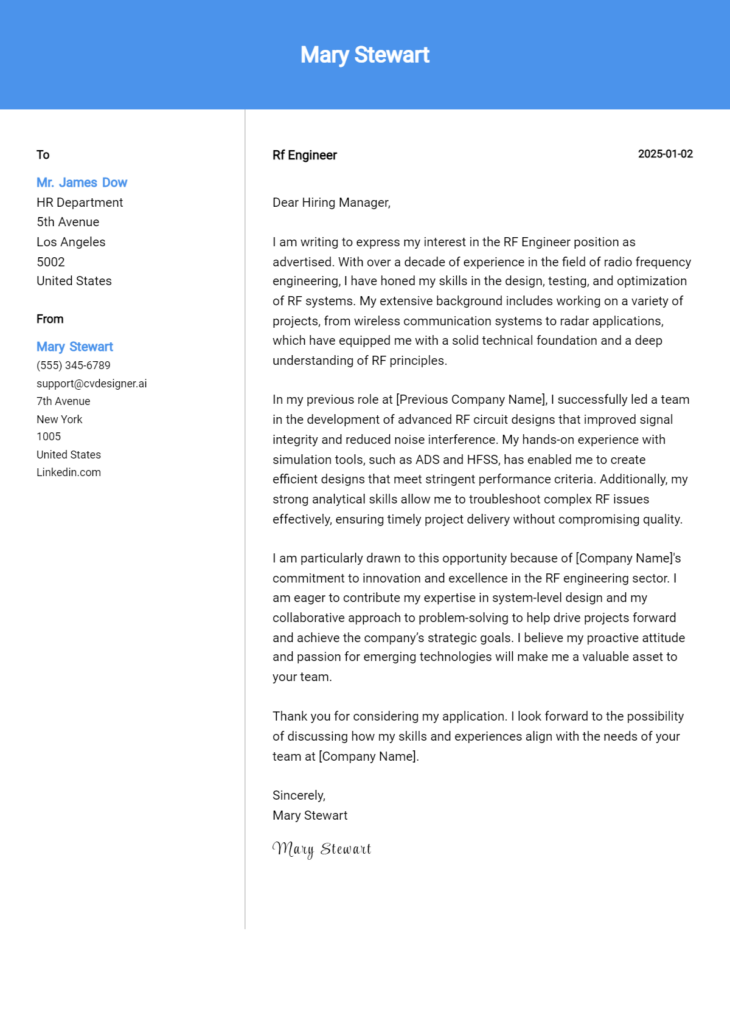Vlsi Design Engineer Cover Letter Examples
Explore additional Vlsi Design Engineer cover letter samples and guides and see what works for your level of experience or role.
How to Format a VLSI Design Engineer Cover Letter
Crafting a compelling cover letter is essential for a VLSI Design Engineer, as it serves as your first impression to potential employers. Proper formatting not only highlights your technical skills but also reflects your ability to communicate effectively and your attention to detail—critical attributes in the VLSI design field. A well-structured cover letter can make a significant difference in capturing the hiring manager’s attention and showcasing your unique qualifications.
In this guide, we will outline how to effectively format your cover letter, providing insights and examples tailored for VLSI Design Engineers.
We’ll focus on the essential components of a professional cover letter, including:
- Cover Letter Header
- Cover Letter Greeting
- Cover Letter Introduction
- Cover Letter Body
- Cover Letter Closing
Each section is crucial for illuminating your expertise and professionalism. Let’s delve into each part and explore how to make your VLSI design cover letter stand out.
Importance of the Cover Letter Header for a VLSI Design Engineer
The cover letter header is a crucial component of your application as a VLSI Design Engineer. It sets the tone for the entire document and provides essential information that helps the recipient identify you and your intent. A well-structured header should include your contact information, the date, and the recipient's details, ensuring that it is clear and professional. This clarity not only makes it easier for hiring managers to reach you but also demonstrates your attention to detail—a vital skill in the field of VLSI design.
Below are examples of a strong and weak cover letter header for a VLSI Design Engineer.
Strong Example
John Doe 1234 Silicon Valley Blvd San Jose, CA 95134 (123) 456-7890 john.doe@email.com October 15, 2023 Hiring Manager ABC Semiconductor Inc. 5678 Chip Lane San Jose, CA 95135
Weak Example
JD 1234 Silicon Valley Blvd San Jose 10/15/23 To Whom It May Concern ABC Semiconductor
In the strong example, all necessary information is clearly presented, maintaining a formal tone and ensuring professionalism. Conversely, the weak example lacks clarity and detail, which could leave a negative impression on potential employers.
The Importance of the Cover Letter Greeting for a VLSI Design Engineer
The greeting of a cover letter serves as the first impression to the hiring manager, setting the tone for the rest of the letter. A well-crafted greeting demonstrates professionalism and personal investment in the application process by directly addressing the recipient. This personalized touch shows that you've taken the time to research and understand the company and its team, which can make a significant difference in how your application is received. To avoid generic greetings like "To Whom It May Concern," it's advisable to look up the hiring manager's name through company websites, LinkedIn, or by calling the organization. A tailored greeting not only captures attention but also conveys your enthusiasm for the position.
Strong Greeting Example
Dear Dr. Smith,
Weak Greeting Example
To Whom It May Concern,
The Importance of a Compelling Cover Letter Introduction for a VLSI Design Engineer
A well-crafted cover letter introduction is crucial for a VLSI Design Engineer as it serves as the first impression to the hiring manager. This opening paragraph must not only capture attention but also succinctly convey the candidate's enthusiasm for the role. By briefly showcasing relevant skills or achievements, the introduction can set the tone for the rest of the letter, making a compelling case for why the candidate is the ideal fit for the position.
Here are examples of strong and weak cover letter introductions to illustrate this point:
Strong Example
Dear [Hiring Manager's Name], I am excited to apply for the VLSI Design Engineer position at [Company Name] as advertised on [Job Board]. With a Master’s degree in Electrical Engineering and over five years of hands-on experience in developing high-performance ASIC designs, I have successfully delivered projects that resulted in a 30% reduction in power consumption. My passion for innovation and my ability to collaborate across teams make me a strong candidate for this role, and I am eager to contribute to [Company Name]'s mission of driving cutting-edge technology.
Weak Example
Hello, I want to apply for the VLSI Design Engineer job. I have some experience in this field and have worked on a few projects. I think I could do well in this position, and I hope you will consider my application.
Purpose of the Cover Letter Body for a VLSI Design Engineer
The cover letter body for a VLSI Design Engineer serves as a critical component where candidates can effectively showcase their technical skills, relevant experiences, and unique value proposition to potential employers. This section allows candidates to highlight specific projects or significant accomplishments that demonstrate their expertise in VLSI design, such as successful completion of complex chip designs, proficiency in using design automation tools, or contributions to reducing power consumption in integrated circuits. By providing concrete examples of past work and the impact it had on previous employers, candidates can convey their capabilities and readiness to contribute to the company's goals.
Strong Example
Dear Hiring Manager, I am excited to apply for the VLSI Design Engineer position at XYZ Technologies. In my previous role at ABC Semiconductor, I led a team in designing a high-performance 16nm microprocessor that achieved a 25% reduction in power consumption, enhancing overall efficiency and performance. Utilizing tools such as Cadence and Synopsys, I implemented innovative design techniques that not only met the stringent timing requirements but also improved yield during fabrication. My ability to collaborate with cross-functional teams and my passion for tackling complex design challenges make me a strong fit for your team. Sincerely, John Doe
Weak Example
Dear Hiring Manager, I am writing to apply for the VLSI Design Engineer position. I have some experience with VLSI design and have worked on various projects. I believe I can help your company. I have designed circuits and learned some software tools. I am a quick learner and can adapt to new environments. Best, Jane Smith
Cover Letter Closing for VLSI Design Engineer
The closing paragraph of a cover letter for a VLSI Design Engineer is crucial as it summarizes the candidate's qualifications, reiterates their enthusiasm for the position, and encourages the hiring manager to take the next steps, such as reviewing the resume or scheduling an interview. A strong closing leaves a lasting impression and demonstrates professionalism, while a weak closing can diminish the impact of the entire letter.
Strong Example
Thank you for considering my application for the VLSI Design Engineer position at [Company Name]. With my extensive experience in digital circuit design and verification, coupled with my passion for innovation in semiconductor technologies, I am excited about the opportunity to contribute to your team. I look forward to the possibility of discussing how my skills and experiences align with the goals of [Company Name]. Please feel free to reach out to schedule a conversation at your earliest convenience. Thank you once again for your time and consideration.
Weak Example
I hope you like my application. I think I would be a good fit for the VLSI Design Engineer job. Please look at my resume. Thanks.
These tips will help candidates craft an effective cover letter for a VLSI Design Engineer position. A well-structured cover letter is crucial as it not only introduces you to potential employers but also provides an opportunity to highlight your technical skills, problem-solving abilities, understanding of the Software Development Life Cycle (SDLC), teamwork experience, and passion for continuous learning. By effectively showcasing these attributes, you can make a strong impression and increase your chances of landing an interview.
Tips for Crafting an Effective Cover Letter for VLSI Design Engineer
Highlight Technical Skills: Clearly outline your technical expertise in VLSI design tools and methodologies. Mention specific software you are proficient in, such as Cadence, Synopsys, or Mentor Graphics. By listing relevant skills, you demonstrate that you have the technical foundation required for the role, making it easier for hiring managers to see your fit for the position.
Showcase Problem-Solving Abilities: Use specific examples to illustrate your problem-solving capabilities. Describe a challenging project where you identified a problem, the steps you took to resolve it, and the outcome. This not only showcases your analytical skills but also emphasizes your ability to think critically under pressure.
Demonstrate SDLC Knowledge: Discuss your familiarity with the Software Development Life Cycle and how it applies to VLSI design. Explain your role in various phases, such as requirements gathering, design, verification, and testing. This demonstrates your comprehensive understanding of the development process, making you a valuable asset to the team.
Emphasize Teamwork: VLSI design often requires collaboration with cross-functional teams. Highlight instances where you worked effectively with others, whether in a leadership role or as a contributing team member. Providing examples of how you facilitated communication and resolved conflicts can illustrate your interpersonal skills and ability to work well with others.
Express a Passion for Continuous Learning: The field of VLSI design is constantly evolving. Convey your commitment to staying updated with the latest technologies and trends. Mention any relevant certifications, courses, or workshops you have completed or plan to pursue. This not only shows your dedication to professional growth but also signals to employers that you are proactive and willing to adapt to new challenges.
For additional resources, consider exploring cover letter templates or using a cover letter builder to create a polished and professional document that effectively highlights your qualifications.
Common Mistakes to Avoid in a VLSI Design Engineer Cover Letter
Crafting an effective cover letter is essential for VLSI Design Engineer applicants to stand out in a competitive job market. Avoiding common mistakes can significantly enhance your chances of landing an interview. Here are some frequent pitfalls to watch out for:
Generic Content: Using a one-size-fits-all approach can make your application seem impersonal. Tailor your cover letter to the specific job and company by mentioning relevant projects or technologies.
Lack of Specificity: Failing to include concrete examples of your skills or experiences can weaken your case. Highlight specific projects or achievements related to VLSI design to demonstrate your expertise.
Ignoring Formatting: Poor formatting can make your cover letter difficult to read. Follow a clear cover letter format to ensure proper structure and presentation.
Overly Complex Language: Using jargon or overly complex technical terms can confuse the reader. Strive for clarity and simplicity while still showcasing your technical knowledge.
Neglecting Proofreading: Spelling and grammatical errors can detract from your professionalism. Always proofread your letter or have someone else review it to catch any mistakes.
Focusing Solely on Technical Skills: While technical skills are crucial, don’t forget to mention soft skills like teamwork and communication, which are equally important in collaborative VLSI projects.
Failing to Show Enthusiasm: A lack of enthusiasm can make you seem uninterested in the role. Convey your passion for VLSI design and the specific company to create a more engaging cover letter.
For further inspiration, check out various cover letter examples that can guide you in crafting a compelling narrative for your application.
Cover Letter FAQs for VLSI Design Engineer
What should I include in my cover letter for a VLSI Design Engineer position?
In your cover letter, highlight your relevant experience and skills in VLSI design, emphasizing specific projects or technologies you’ve worked with. Start with a strong introduction that outlines your enthusiasm for the position and the company. Include your educational background, focusing on degrees and certifications pertinent to VLSI. Discuss your proficiency in design software, such as Cadence or Synopsys, and any experience with hardware description languages like VHDL or Verilog. Mention your ability to work collaboratively in a team and your problem-solving skills. Finally, conclude with a call to action, expressing your desire for an interview to further discuss your qualifications.
How can I tailor my cover letter for a specific VLSI job?
To tailor your cover letter, research the specific company and the job description thoroughly. Identify the key skills and experiences they are seeking, and align your qualifications with those requirements. Use specific keywords and phrases taken from the job listing to demonstrate your suitability. For example, if the position emphasizes experience with low-power design, elaborate on your relevant projects and how you successfully implemented those techniques. Personalize your introduction by mentioning the company’s recent projects or achievements that resonate with you. This shows that you are genuinely interested in the company and have taken the time to understand their work and culture.
How do I demonstrate my technical skills in a cover letter?
Demonstrating your technical skills in a cover letter involves providing concrete examples from your past experiences. Instead of simply stating that you have expertise in a specific area, describe a project where you applied that knowledge. For instance, you might mention a particular VLSI design project where you implemented a novel algorithm that improved performance or reduced power consumption. Highlight any achievements, such as meeting tight deadlines or exceeding performance benchmarks. Additionally, you can mention relevant coursework or certifications that reinforce your expertise. Using metrics, like a percentage increase in efficiency or reduction in area, can further substantiate your claims and make your skills more tangible to the hiring manager.
Should I address my cover letter to a specific person?
Yes, addressing your cover letter to a specific person can significantly enhance its impact. Research the company’s HR department or the hiring manager’s name through platforms like LinkedIn or the company’s website. Using a specific name adds a personal touch and shows that you’ve made an effort to connect with the organization. If you cannot find a name, using a general greeting like “Dear Hiring Manager” is acceptable, but it’s less effective than a personalized approach. A direct address can also help you stand out among numerous applicants, as it demonstrates your attention to detail and genuine interest in the position.
Build your Cover Letter in minutes
Use an AI-powered cover letter builder and have your letter done in 5 minutes. Just select your template and our software will guide you through the process.

